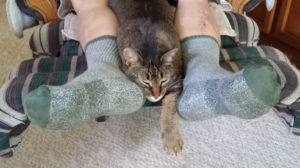Ruby and I start May with a phenomenal morning. She performs her obeisance with much confidence – if not all the way stretched yet. I will use the word “bend” to ask her to do this. She lifts her front left hoof on “lift your foot” and, when I say “hold,” lets me hold it in my hand. As I attach the hobble, she steps around, trying to see what I am doing.. I do not use the hobble to lift her foot. I only use it to encourage her to hold her leg up after she has lifted it on my voice request – and while I reach the candy cane or carrot under and ask her to bend. She does surprisingly well the very first time. On one attempt, she bows right down to the ground. I guess we are ready for the knee pads! I try to thread the carrot onto a pen tip so that her teeth are not so close to my fingers. I swat her nose and tell her to wait. When we are through with the session, I walk her to the back pen where there is a huge mud puddle left from the rain. She both walks through and stands in it but, when I stomp my mucker to make a splash, she is left to wonder. I will have to get her a swimming pool! I have not yet attempted to give her a hose bath.
May 2 ~ I might as well teach the other three girls to bend, bow, kneel, and lay down along with Ruby. Today, we work on the bend and they all respond well. I use a three-foot white wand to touch each of their legs; asking them to lift each independently. Zena is not sure about having her rear legs touched. I think maybe she has endured some whip abuse back there. The moment the wand barely touches her, her legs are up high and wide. I use the hobble with Ruby to hold her leg up as she bends and bows for her candy canes. On her last of five attempts she rests her knee and cannon quietly on the ground and I lavish her with praise and treats.
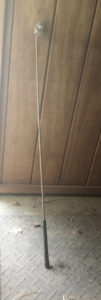
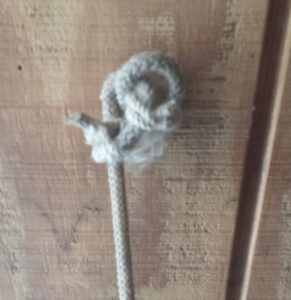
What a wonderful, wonderful morning! It is sunny and dry, with no wind, and warm enough to offer Ruby her grain in the barrow outside. We are now at the fourth post from the end of the east pen. Every so often, she lifts her head, furrows her brow, and scans the trees beyond. But, for the most part, she eats quietly. When she is finished, she opts for grass rather than a return to the barn. Zena has hay in her stall, but I can hear that Sara and Sparky are impatient for theirs. Upon returning Ruby to her stall, I begin morning training. Bending for the treat between front legs, lifting the front left leg and bending further, and lifting whichever leg I touch with my wand while saying, “Pick up your front left,” etc. Sparky is so short that I have to practically kneel myself in order to reach under and between her front legs to give her the treat. But, in every instance, I ask them to go slowly so that I can calmly deliver the treat to their mouth. They are learning nicely. Sara’s Haflinger neck is so stout that it is a difficult reach for her. I ask her to step her front feet onto the box to help her with the obeisance; before asking for her to perform on the ground. On her last try, her left knee comes within three inches of the ground. Zena has the opposite problem. It is practically going on vacation having her long “new-style Morgan” neck travel all the way down to her knees. I use Pogue’s advice to tickle her whiskers in order to have her follow my hand. She, too, shows improvement from yesterday. When I use my wand to ask her to pick up specific feet, like yesterday, it is clear that she has a history of whips snapping her back legs. She lifts high and far with wariness in her eye. I tell her she is a GOOD GIRL and lavish her with praise and treats. When I tap her front legs and ask, she “parks out” in the show pose taught to Morgans, Arabians, Saddlebreds, and Tennessee Walkers. She clearly remembers that from her younger days. And, lastly, I play with dear Ruby. For the other three girls, instead of using the hobble, I just snapped the lead rope around their left front pastern to remind them to keep their leg up. But, with Ruby, I employ the hobble because I think she may go further down. I am not sure that it makes a difference because there is essentially no resistance on the rope. I could simply hold the hoof with my hand; but choose not to because my face might be too close to the hoof. Now, Ruby is impatient and does not want to wait for me to buckle the hobble. She is already dropping her head between her legs. So, I ask her to step her front feet onto the box just so she can see that I am trying to buckle the hobble strap. Back on the ground, I treat with pieces of carrot when she bends her head through her legs. She bends thoughtfully, so I have time to pass the treat into her mouth. She is already dropping her knee to within inches of the ground, so I switch over to the six longer candy canes I unwrapped and held in my pocket. On the first request to really reach for the candy, she sets her knee on the ground for a good two seconds before lifting herself back up. I lavish her with praise and give her small treats while standing. On the second or third attempt, she lays her cannon on the ground and stays for three of four seconds – long enough for me to give her small treats in that pose. I give her more when she comes up, lots of scrubs, and “GOOD GIRL – that’s what we’re looking for.” She gives me two more complete kneels, before expending the candy canes. I am wondering whether I will be able to teach her to pick up individual feet on command by just looking at them and saying “pick up your back left” or whichever – without pointing with a wand. That would be cool.
After putting out hay and horses, I pull out the hose, scrub the water tank and let it fill while I pick the arena and pen. As I am standing in the causeway, rolling up the hose, Ruby steps up into the causeway, too. With the hose running between her legs, she squeezes a turn-around in an attempt to pull her halter off the rack. I have to shoo her out because Gary and I are driving to the Detroit Zoo today to hear a talk by … Carl Safina! He will be promoting his book BEYOND WORDS: WHAT ANIMALS THINK AND FEEL – which I certainly hope you have purchased and thoroughly enjoyed!
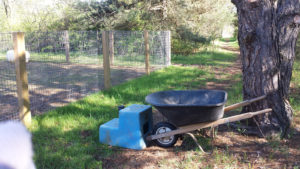

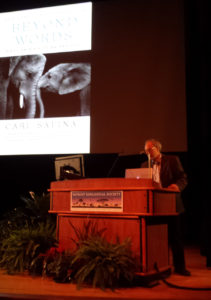
Last night’s visit to the Detroit Zoo was fascinating. There were a hundred and forty zoologists – comparative animal biologists and psychologists – gathered from around the world to debate and discuss modern zoos. Opinions ranged from those who believe it is appropriate to euthanize certain animals because they have no value in a zoo’s gene pool, to those who believe zoos should become a thing of the past – that we can teach the masses to value wild animals through technology – movies, whatever. Two years ago, there was worldwide on-line outrage when a zoo in northern Europe opted to euthanize a two-year-old male giraffe because his genes were incompatible with their program – even when other zoos offered to adopt him. In the end, the zoo murdered him and fed him to their lions.
After Safina’s lecture, I stood in his autograph line with my copy of his book. I could hear each attendee ahead of me say either Elephant, Wolf, or Whale – indicating which section of his book they most enjoyed. When it was my turn, I said, “Horse!” Well, that was a mistake! He replied something like, “Horses? Horse Owners? Shame on all of you. I meet people who love animals and I meet people who can slaughter animals with no remorse; but only the horse people can claim to love their animals while lobbying for laws to protect their rights to abuse them! Shameful!” I stood quietly aghast before responding, “Well, that’s why I’m here.” But, he was already on to signing the next book. There is nothing more I can say because he is absolutely correct.
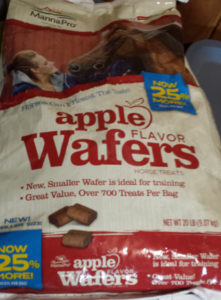
May 7 ~ Gary and I return to the Detroit Zoo; this time for an evening lecture by Dr. Marc Bekoff, professor emeritus, University of Colorado-Boulder. An author of numerous books, Bekoff’s most recent is REWILDING OUR HEARTS; BUILDING PATHWAYS OF COMPASSION AND COEXISTENCE. I have one of his books at home; but purchase this one tonight. He, too, is part of the international conference of zoologists convening at the zoo. He believes zoos should only serve as rehabilitation facilities for wild animals, and life-long homes for those who cannot be returned to their habitat. One must realize that zoos design their environs to house the specific animals they hope to acquire. Having access only to re-hab patients would limit their ability to plan their housing and enclosures; or to offer the well-rounded experience they desire for their visitors. I am emotionally torn, because I believe zoos give ordinary people like me the opportunity to see global animals up close – and that does help me to fall in love with them. But, if this is my conclusion, then I am part of the group that believes it is okay to sacrifice one animal to a life of confinement “for the greater good.” Bekoff disagrees. He believes that every single animal’s life is a life worth living. Some authorities on the subject dictate that these two schools of thought define the difference between animal welfare and animal rights. “Welfare” means that we can do what we want with them, as long as we afford them reasonable comfort in the process. Who defines “reasonable” is up for grabs. “Rights” means that each animal is an individual in its own right, and must be treated as such. If we pause long enough to apply these definitions to ourselves – to humans – it offers valuable insight. It would mean a huge increase in the study of, and implementation of, early childhood education. It would mean a huge increase in the study of, and implementation of, prison reform programs. It would mean universal healthcare. It would mean an end to warfare.
It is May 6, and I meet Marsha for breakfast at a local restaurant to catch up on her and Lucy’s time at their reining stable. She describes what other boarders call free-longeing in the arena. They are simply cracking whips to make their horses “exercise” themselves. She is aware of more than one minor accident where the horse owners were not notified. With Lucy’s stall right next to the gate into the arena, she says there is no peace. It was so clean and apparently well-organized when she first visited. Like many corporations and marriages. Looks good on the outside. But, Marsha works long days a full hour’s drive from her house. And, this stable is so close to where she lives.
May 7 ~ Today is a big day in the barn. Wende Berry brings her twenty-seven-year-old autistic niece, Katie, for morning feed. Katie is tickled to be around the horses, and I enjoy my time with her. Wende has obligations at home, but I tell her to leave Katie with me. She is still here when Kim and Ava show up to ride. They have left five-year-old Lucca home because she wants to invest no more than an hour in barn time. Kim and Ava say that is just not enough. Ava gives Sparky a good brushing and a great finger scrub before doing most of her western saddling herself. She leads Sparky around the arena while Kim and I brush and saddle Sara. Busy chatting between ourselves, we are surprised when Ava loudly announces that she is in the saddle She has mounted on her own from the ground. She dismounts and remounts from the ground to prove it. While Kim is mounting and walking Sara in the arena, and readjusting her saddle, Ava asks whether she can head out the chute and into the pens. I do not expect that Sparky will leave the arena when there are no other horses out back. But, next thing I know, they are out the door. I peek and see that she and Spark have stopped at the end of the chute. I am not sure whether she asked for the stop or whether Sparky just decided that was as far as she wanted to go. But, when Ava presses with her calves, Sparky moves on out, and they wander the far corners of the east pen on their own. We all enjoy a bit of time in the pens before I put pony-pullers on Sparky so that Kim and Ava can ride the ten acres. The pony-pullers will keep Sparky from grazing – something that frustrates most novice riders. Katie and I walk out after them so that I can keep an eye on whether Sparky is behaving for Ava. After one lap of the trails, they head out a second time and I stay back at the barn. After returning Katie to Wende, I show Kim and Ava how much of the bow and kneel each of the girls know thus far.
In the evening, the girls head out back for a good hour and a half of grazing; while l roll a wheel barrow behind them to pick up sticks along the path. I am amazed that Ruby sticks like glue to my barrow as I fill it with very large sumac twigs. Each time I move the barrow further along the path, she follows – until I finally head with a very full barrow to the very back, and around to the stick pile by the back gate. When I retrace the path with the empty barrow, Ruby again wanders over to inspect. I return to the barn to put out hay and open stall doors. When I whistle them in, they opt not to come. After six whistles, I get the longe whip and head out back to remind Sara of her leader’s obligation. But, instead of bringing them into the arena, she leads them up the path, and around, to the outside front of the arena. When I catch up with them – which takes me a minute or two – I chastise her for not going into the arena. Yes, I am bad-mouthing Sara for not having the good sense to cage her animals. It is pretty silly. When Sara trots into the arena and realizes that I have not yet put food in the stalls, she trots right back out, and canters her little herd away. I trudge halfway back on the ten and, with one crack of my whip, she takes the girls across the property and up past the round pen to the locked side of the little red barn. When I let them in, after TRUDGING back up from the back again, I realize that Sara’s stall door is the only one not open! She could not have gone obediently into her stall – even if she had wanted to. After graining, Sparky lingers with me in the arena while I wait for Ruby to finish her ration. I think Sparky is looking for tricks-for-treats. When Ruby comes out of her stall, she lingers with me, too. We walk together to join the others. What good girls.
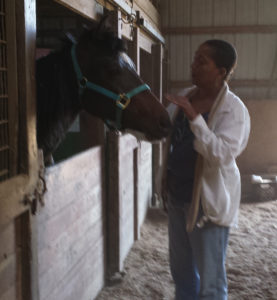
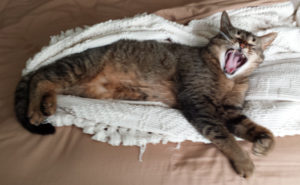
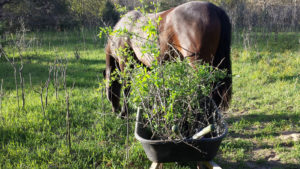
May 8 ~ This morning, for the first time, I train each horse inside their stall before putting them out for hay. Sparky bows, and lifts her leg readily – but is not ready to put her knee to the ground. Sara puts her knee to the ground for the first time. She is even a bit surprised when the knee touches, but gets lots of praise and treats for it. Zena will bow, but is just getting the hang of lifting her leg for the kneel. Ruby is confused when I ask her to work in her stall. This surprises me. We walk to the center of the arena and she gives me a knee to the ground. I realize I have not been consistently using word cues with the deeds. Silly, inconsistent me. “Bow” for head between the legs. “Lift Your Leg.” “Kneel” for one knee to the ground. Ruby backs for me when I ask her to, while standing at her shoulder, hip, and tail. That’s nice. She does not want to stop playing and join the others, so we complete a figure eight and a follow-my-feet. She is not very good at follow-my-feet. Not very good at all.
In the afternoon, I accompany my sister, Carol, as she drives her youngest son, Dylan, to the Detroit airport for a flight to Africa. I cannot believe this young boy, a sophomore at Michigan State University, is flying off to Africa – via a couple days in London – on his own. He has always been so quiet! But, as soon as he transferred from our local junior college, with plans to major in zoology, he managed his way into a travel course to help collect blood for hyena research that is taking place at a number of universities around the world. Fascinating!
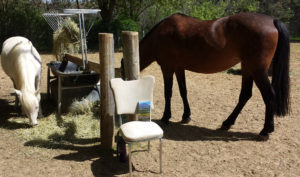
May 9 ~ A beautiful morning in the barn – but not a quiet day! Sparky works on her bowing, and then Sara. The two of them are in the arena together, taking turns for a bow and a treat, until Sara decides it is not fun to share – and heads out back to the hay. I work with Zena, and then Ruby – who wonderfully, quietly lowers herself to her knee. She follows me into the tack room and pulls Sara’s saddle pad off the rack. So, I pad and saddle her with the old Abetta western and snug it up tight. She is fine with it. I ask whether she wants to follow me out to the arena – forgetting to tie the stirrups above the seat! There is enough room for Ruby to walk through the door but, as she does, the stirrups catch and she panics. I am standing in front of her, and I have the canvas stall guard clipped across the opening to the arena. It had been my intention to keep the other horses from coming up into the causeway – and Zena is standing on the other side. Ruby bolts, catching me between her and the guard. Fortunately, the dog-snaps on the guard breaks as she and I go bowling through. I am clearly thinking that I am going to fall down the step into the arena and she is going to trample me. Instead, her momentum spins me to the side, where there just happens to be a foot of free space between the door and the front of the first stall. I land standing safely there while Ruby bucks madly about the arena, before settling into a heavy canter around and around – maybe four times – the perimeter of the arena – and then races through the chute and into the pens. As she races back in, she loses her footing, lands on her side, scrambles back up, and stands panting in the middle of the arena. The other horses are, of course, part of all the cantering but, at the end, they all stand quietly to sniff and visit with her. There is much conversation going on but I cannot understand what they are saying. Much conversation of which, because of my human ineptitude, I cannot be a part. I am so thankful that I had the saddle tight because, otherwise, it would have slid down around her belly. That would have been much worse. I have only once in my life had to un-strap a belly-saddle on a scared horse. Not fun. As is, it is not going to be safe for me to approach her right now. She could buck and catch me, the saddle could slide, whatever. So, I just let her heart settle down while I quietly visit from near the door to the causeway. After ten minutes, she comes to me. I am thinking that, if I can get her back into the tack room, where she is comfortable, I can maybe remove the saddle. I walk into the tack room and she surprises me by following. But, while I am getting a small container of grain, she goes back out into the arena! Through the door that originally scared her. I put the other girls in their stalls and, after a few minutes, Ruby agrees to go into hers. While she is eating a bit of grain, I lean over the half-wall and begin to untie the cinch. I hold the saddle and strap such that it continues to feel snug until I have the latigo completely undone. I do not want her to feel it loosen because I do not want her to move quickly – causing the saddle to land on her side or belly. When I pull the saddle off, the cinch remains across her back and she is fine with that. I leave the saddle sitting on the half-wall and, a few minutes later, put a couple treats on its seat for her. She has a tiny scrape on one eyebrow, a small scrape on her shoulder – I am guessing that is from the broken dog-snaps – and a smear of blood on one nostril. That must have happened when she lost her footing. I check the other horses and Sparky has a small cut on her shoulder and a four-inch-long scratch down her spine. I am not sure where or when she got caught up in the commotion. I apply salve on the exposed areas. I stop to ponder that I could have died in that doorway. I decide to not tell Gary all the details. Later in the evening he says something like, “You know I worry about you being alone in the barn. That could have been worse today.” My response is that, if he is not in the barn, then I guess he will just have to worry. He could have chosen to participate thirty-five years ago, and he chose otherwise.
In the early evening, Amanda Richard comes for a trail ride and opts for Zena. But, Amanda has not ridden since last fall, and Zena proves a bit much for her. Not dangerously bad, but a handful – that big Morgan trot that competitive show people love in their horses, and that the Amish buggy driver demanded. When Amanda says she might want to get off and walk, I tell her that is fine. It has always been my belief that we should listen to our butterflies. If our stomach says we are in real physical danger, then we should dismount before it is too late. If the butterflies are just fluttering about an imagined danger, then we should stop to consider why the activity is triggering that emotion. Work it through on the ground, not where we can feed it into the horse. We both dismount and visit our way home. As we put all the horses out for the night, I want to show Amanda Ruby’s bow. But, Ruby’s right knee is tender and, even though she lifts the left leg before I ask, when she stoops down, she cannot go as far as usual. I am sure it is the right leg that hurts. So, we give her lots of loves and scrubs. She is not interested in going out with the other horses because she has been eating hay while we were riding Sara and Zena in the park. But, we finally tell her we need to get in. It is dark as Amanda heads for home.
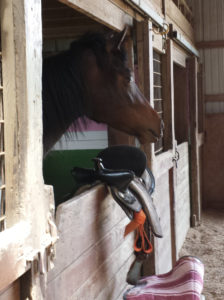
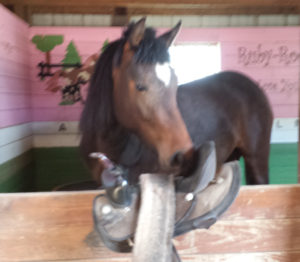

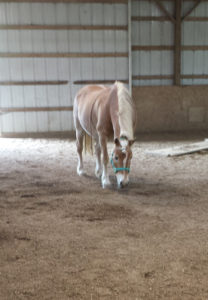
May 10 ~ My friend Judy stops in for an overnight while returning from her family in Buffalo, New York, to her home in Traverse City. She, and Kim and I, enjoy a very good trail ride. Before she heads home, we are joined by my sister Carol – who not only recently lost her husband to cancer, but now has lost her youngest son to Africa – to laugh our way through Meryl Streep’s MAMA MIA. It is one of a few movies I can watch year-after-year. It just makes me feel alive.
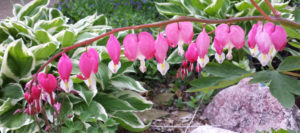
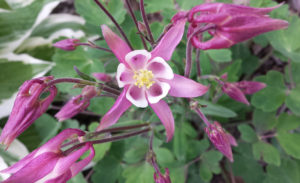
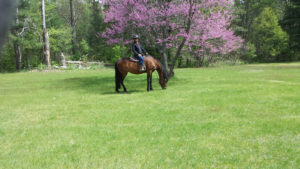
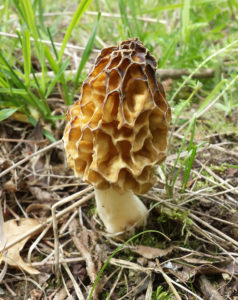
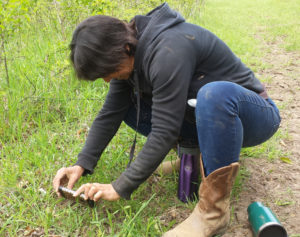
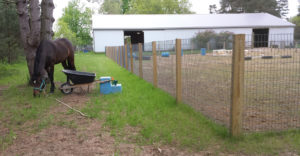

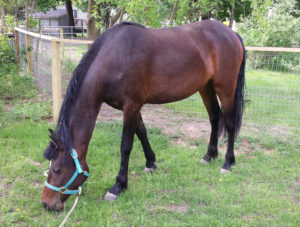
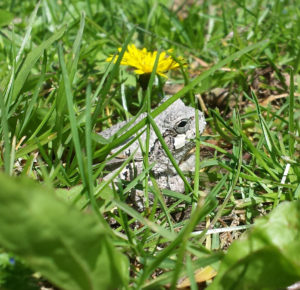
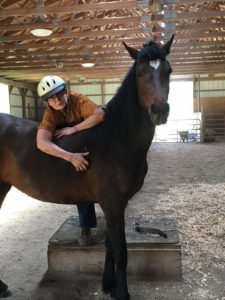
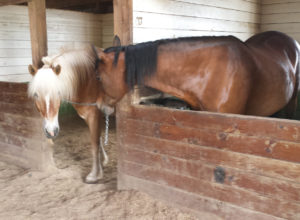
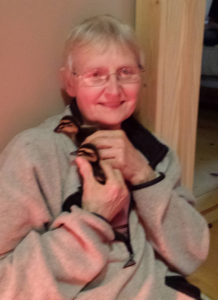
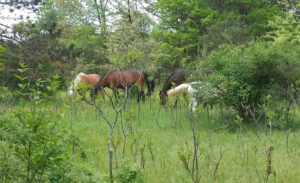
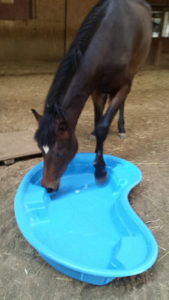
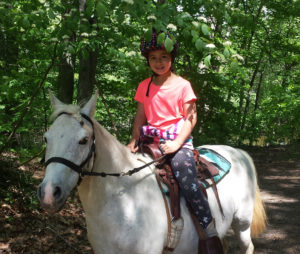
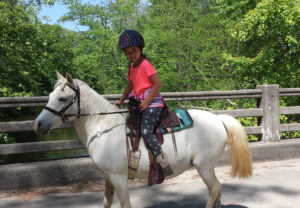
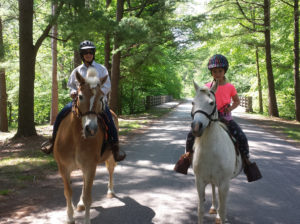
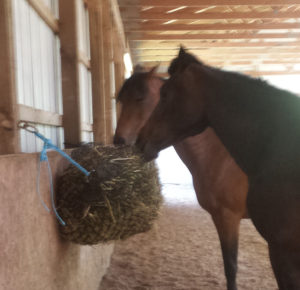
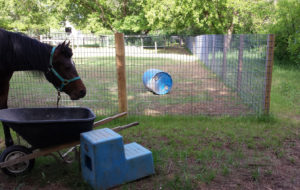

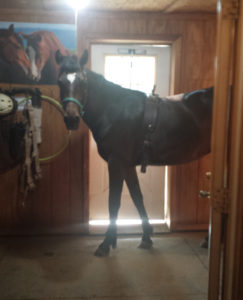
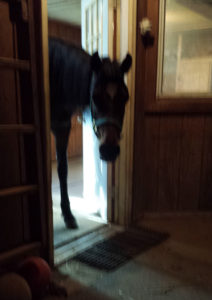
Kim and I wrap up May with another good trail ride. Doc Lisa drops in to administer Rabies vaccinations and West Nile boosters; and I de-worm the horses. My sister’s first grand-baby is born. Her oldest boy had been married just a year when her husband developed cancer. So he and his wife thought they could give him a grand-baby before he died. They were not soon enough but Carol, who is still raising the last of her five, is thrilled with little Max.

